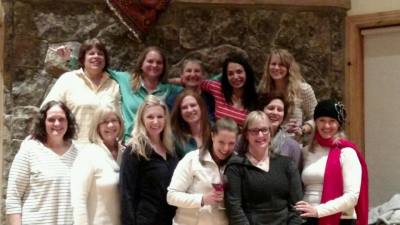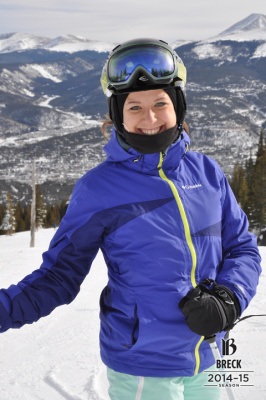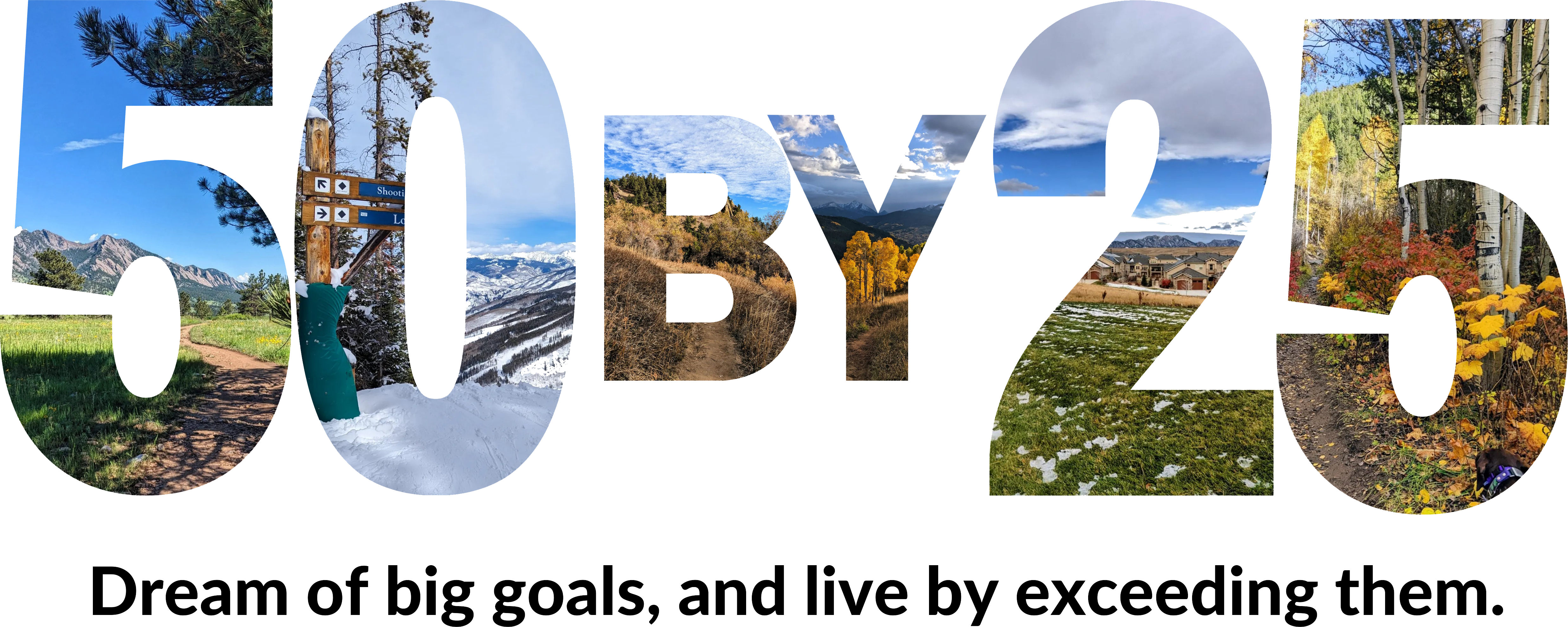Today I played “ski bum” by skipping work and heading out to the mountains. After a gorgeous drive out with no traffic on I-70 (hooray for leaving on a weekday morning!), I arrived at A-Basin and was able to get in about a dozen runs. It was definitely a little bit icy – which is to be expected for early season – but I did pretty well, and found myself really comfortable on all the intermediate terrain. I wasn’t straightlining, by any means, but I was definitely taking a more vertical approach than carving wide turns like you do as a beginner.
Around 4pm, I called it a day and then headed over to Breckenridge, where I met up with my roommates for the weekend – the awesome Bold Betties group. I had only done one event with them before, and I actually didn’t know a single person on this trip, but they turned out to be a blast! We had a wonderful Friday night cooking dinner at our gorgeous rental home, sipping wine (and homemade moonshine that one of the women brought – delish!), and getting to know each other.

Most of the women in the group were taking snowboard lessons the next day, so I ended up skiing on my own and planning to meet up with them for lunch. In the end, I didn’t get to spend nearly as much time with all the women as I would have liked, but I do feel like I made some great friends and will look forward to meeting up with them again soon!
Since I had spent the previous weekend skiing solo as well, I knew the drill. I popped my headphones in and headed up Peak 8 on the Colorado Superchair. And for once, I decided to ignore my usual MO of starting out on something super easy: I went right for the intermediate Crescendo, got back to the base pretty quickly, and then headed for the Rocky Mountain Superchair, which had a shorter line. At the top of the lift, I zoomed down Pathfinder to build up enough speed to cross over a bit of flat terrain, and then plunged quickly down North Star.
Okay, so all of that probably means nothing to 99% of you. But the previous week, I had been pausing at the top of North Star (an intermediate trail) and honestly getting a little scared. When you cross over to get to the top of the trail, you’re usually going pretty slow from the flat section to get there, and so pausing at the top is natural. Furthermore, North Star has a bit of a steep drop right at the very top, but then it smooths out and is squarely intermediate (and probably even an easy intermediate) the rest of the way down.
What I realized this weekend was that I needed to just go for it without really stopping/thinking/staring at the trail. Rather than tentatively turning my skis to the side and starting the drop with a gliding horizontal wide turn (and a slow speed at which I inevitably would slip a little bit), I needed to point my skis downhill and go fast and fearlessly. Far from being scary to take the plunge right down the slope, it ended up being really fun to do that part – and I could feel that my technique was much better and my attitude more confident! I spent the day actively seeking out the steep sections of trails and seeing how many I could string together on a single run, rather than doing more of the easy terrain and minimizing the drops.

This was corroborated even on the not-so-steep portions of some of the other trails. Any time I went on an easy trail or adopted that beginner skiing technique of taking wide S-shaped turns and cutting straight across the trail, I lost a lot of my skill and my confidence. But when I pointed my skis downhill and used my hips to alternately drive one ski and then the other into the snow (slowing me down but not really going back and forth or turning my skis horizontal), I skied well and I felt great about how I was doing.
When I went skiing last weekend, I learned that I’m better than I think I am, and that I should really push myself harder on trails that test my abilities. This weekend, I validated that by finding that if I’m on a trail that’s too easy or that I’m taking easy, I’m actually shakier on my skis and I’m not going to do well. But I also learned this weekend that there’s no room for being tentative in skiing – I need to be fearless and just take the plunge to go straight down the mountain. Sometimes, harder is easier, and so it doesn’t make sense to be afraid of a challenge.
Life lesson as well? Probably.

Skiing and I do not get along. LOL. I am just so awful and even though I take a lesson every year that we go to the mountains, I hate it. The point I’m trying to make is that I think you’re approach is pretty awesome even though I could never have the guts to do it myself 😉
The difference is not that you are not able to develop the skills necessary to be confidant skiing, but that [probably] you were not able to begin skiing while young. To learn something when you are young, when you know that nothing (of any seriousness) can hurt you, is a powerful advantage.
The beauty to choose to practice intentional living is to bring back a child-like sense of wonder to all activities. And the ability to live like a child while being responsible as an adult is a beautiful goal in life.
I love how Laura was able to intentionally be that child again on the ski slopes. And, I have a few additional challenges (once this whole arm surgery things is past): let your entire body relax into the skis, look far down the hill, and [most importantly] take at least 2 solid crashes each day on the mountain.
Why do I want you/her to crash?
Answer: What is a better way to improve than to make mistakes yourself and have to correct them?
I was lucky enough to learn to ski when I was reasonably young (probably around 6 or 7?) but was never very daring even then. I have always been a cautious skier, but it’s really paying off to be more aggressive! Totally agree with you on the value of making big mistakes and learning from them, too.
How do YOU try to get that child-like wonder in your activities? I’d love to hear some tips.
If you weren’t pregnant I would totally make you come out and ski with me here 🙂 So maybe next year?
How do I try to get that child-like wonder in my activities?
Be present in every moment. After thinking about it the last day, this mental attitude is the key for me to maintain child-like wonder, while also living as a responsible adult (responsible meaning taking ownership of my actions, not to be safe).
Yesterday I watched a new-born track with their eyes all the visual stimuli around them. These wide eyes and open mouth constantly amazed at everything – especially as Daddy rotates, turns and switches the view seemingly at random and so much in control. The amazement of the newborn as this spoonful of delicious food – coming out of nowhere – by this beautiful female who has been imprinted as their mom. Where did that come from? How did you know I would like that so much? Slow down, I can’t see everything you get me to look at that fast. Those being just a few of the thoughts I imagine this newborn wanting to say. Watching this very young child gave me the sense it was (much more than the parents) present in every moment, because they had to. They had to start assimilating all these new stimuli in their brains making connections.
Being present every moment for an adult is a cultivated state of mind that we are constantly working toward. Probably the easiest way to picture being present is reading a love letter. Every time we read a letter of love from someone we care about, we read it as if for the first time. We see each word as if we are seeing it for the first time. We unconsciously ask ourselves to feel the emotions that we felt when reading this letter for the first time.
Making games at work, at home, with friends. Starting many sentences with the phrase: “I wonder…” I wonder how many wild animals I will see today? I wonder how many people I can make smile today? I wonder if I can make this routine task easier/better/more meaningful?
Sports enables child-like wonder. First in the mere participation of the sport, the playing. But also the increased fitness and athleticism necessary to do the sport. It is an interesting paradox: the older I get and the fitter I get then the younger I feel and see things for the first time again. Running – and particularly races – kindles that child-like state of mind more than anything. During training I am the adult, learning, strategizing, pacing, increasing fitness. But then the race, the gun goes off and I am just running. Like when I was a child on the playground my only thought is to be the first one across the field, line.
It is not the winning in sports that is the child-like wonder or the being present in the moment, but the idea of seeking excellence. It is when we (I) seek excellence that my mind is aroused into this heightened state of awareness. I am less aware of the physical world, but more aware of the spiritual world, of what it really means to live.
So, there are a few ways in which I have kept child-like wonder in my life as much as possible. Seeing…
…for the first time, again. Wondering. Sports. Being present. But the best way, by far, well, hopefully you will find it…
Danny, that is amazing description of a newborn and their thoughts! I am currently reading “Some Luck” by Jane Smiley and she does an amazing job capturing the exact kind of wonder and curiosity you are talking about (at least in the opening chapters; I’m not very far into it yet).
I was really intrigued by your “I wonder” statements. Do we become more or less childlike if we ponder “how many animals will we see” or “how can I make more people smile?” Personally, I “wonder” if making it a goal rather than something that may or may not happen (and it doesn’t really matter either way) is what separates us as adult rather than children… and, whether that is a good or bad thing. You know I love goals, but perhaps sometimes goals get in the way of allowing things to take their natural course and allowing us to be happy with that outcome no matter what it is.
careful Laura! It is not an either-or proposition! The child-like wonder, the imagination, goes hand-in-hand with goal setting. Goals that become reality initiate from the imagination. Denis Waitly says, “where there is life there is hope, where there is hope there are dreams, where there are repeated (his emphasis) dreams there are goals, and when goals are set action plans form.” Keeping the child-like wonder, the imagination, enhances our ability to dream. And as our dreams are repeated over and over we internalize them. At that point, then we must prepare for the avalanche of successes and achievements as we quickly set and conquer goals: lifetime goals, as soon as possible goals, 5 year plan, 6 month campaign, daily objectives. The imagination and the child-like wonder are the key elements at getting our contrary, lazy minds to embed our dreams and goals in our subconscious; so that everything we do goes towards turning our imaginations, our dreams, our hopes into reality.
And as far as “allowing things to take their natural course…” I have one thought. There is nothing wrong with having goals every day to achieve. Achieving or not achieving goals should not influence the contentedness or happiness of the moment or life. That being said, if the daily goals to be achieved are more tension reliving goals rather than achievement goals – and that is a consistent habit – that is a time to reflect on what I am doing. Tension relieving goals would be a way of spotting apathetic responses to life. Perhaps a way to enjoying the beauty or joy of nothing, is to find and eliminate the tension relieving goals, and then utilize that time (that would otherwise have been occupied) to do nothing (Yiquan-style).
Lastly, I read a few pages of Some Luck via the inside peek feature of Amazon. I think I might have to get that for my Lady Friend as a special gift sometime in the future. Thank you for pointing me there! (and maybe I’ll read it first!)
Yes! My inlaws typically take us on an annual winter ski trip… I’ll just convince them of Colorado next year. And I’m going to make my kid ski as soon as he can stand up 😉